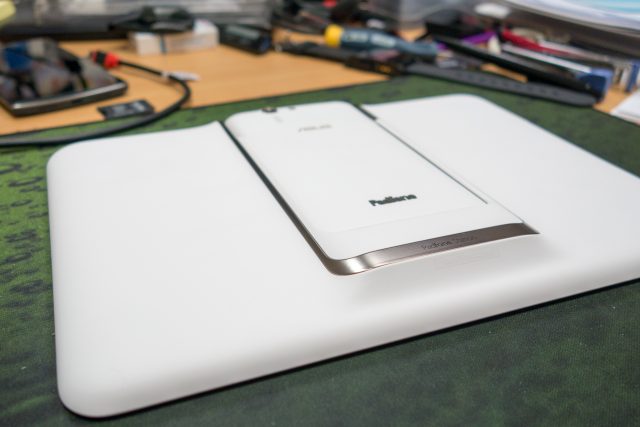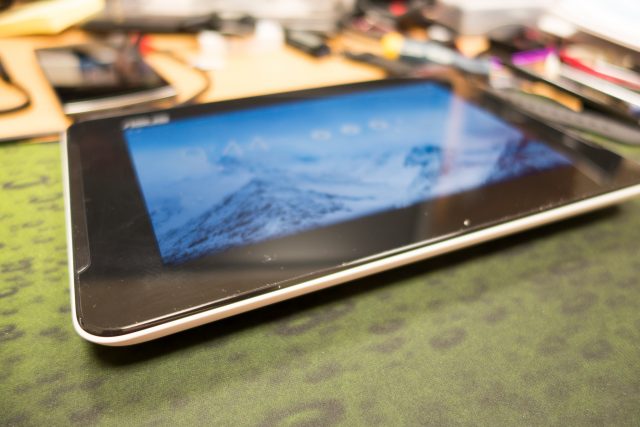 I recently reviewed the ASUS PadFone S. It’s a pretty good smartphone on its own, sporting premium specifications at very reasonable price. The highlight of the PadFone S, of course, is its ability to dock into the PadFone S Station, turning the duo into a full-fledged tablet device. We’ll look at this ASUS PadFone S Station in this review.
I recently reviewed the ASUS PadFone S. It’s a pretty good smartphone on its own, sporting premium specifications at very reasonable price. The highlight of the PadFone S, of course, is its ability to dock into the PadFone S Station, turning the duo into a full-fledged tablet device. We’ll look at this ASUS PadFone S Station in this review.
To be honest, my first impression of the PadFone S Station is its unwieldy size. It’s 9-inch display is surrounded by a generously-sized black bezel, and overall the tablet feels a little clunky. The official specifications put the dimensions of the pad, as ASUS refers to it, is 250.4 x 172.25 x 11.63 mm (WxDxH). That looks about right, but it doesn’t include the raised mid-section where the PadFone S smartphone itself docks into. The total thickness, with the lip of the dock section, comes up to about 20 mm.
The heft, in part, also comes from the weight of the pad. It’s 514 g on its own, which isn’t already exactly in the lightweight category. Add the PadFone S, which is 150 g, and you’re looking at 664 g for this PadFone S Station.
Alright, enough about the size. Let’s look at the duo in action.
Conceptually, I do like the idea of a two-in-one device. The PadFone S is a fully functional Android smartphone. The PadFone S Station on its own, i.e. without the smartphone, isn’t quite useful, as it doesn’t have processor, storage, or wireless radios for network connectivity. Once you dock the PadFone S smartphone into it, the two devices become one. The smartphone’s display moves to the PadFone S Station’s larger 9-inch WUXGA (1920×1200 resolution) display. Everything on your smartphone, like the apps, your photos and videos, and whatever other content you have, is now available on the PadFone S Station.
If you had otherwise owned a separate smartphone and tablet, there’s always going to be this issue of your files being on one device but not the other. Of course, you could use cloud storage to sync your content, but not every content can be sync’ed so seamlessly, or at all. Some app data, for example, are just stored on the local device. The apps, that you install on one device, have to be installed on the other.
The beauty of the PadFone S Station is that it is an extension of your phone. It’s not a separate independent tablet.
Apart from the 9-inch 1920×1200 resolution display already mentioned earlier, the PadFone S Station does have a number of other features. There are two large speakers on the left and right edges of the tablet, giving you good stereo sound for watching videos. How you’d prop up the PadFone S Station is another matter altogether.
There is a 1 MP camera on the front panel above the display. This is in addition to the 2 MP front camera on the PadFone S smartphone itself, which can’t be used once the smartphone is docked into the PadFone S Station.
The PadFone S Station has a Micro-USB port on the left side. It can be used to charge the tablet’s built-in 4990 mAh Li-Po battery. A nice feature is that the tablet can charge the PadFone S smartphone when the latter is docked.
The PadFone S Station is no slouch when it comes to performance, scoring 42153 on AnTuTu Benchmark, about the same as the Samsung Galaxy S5. Of course, it is the smartphone that is the power behind the tablet.
I had hoped that the PadFone S Station would offer more ports and connectivity options. Apart from the single Micro-USB port already mentioned above, it would have been nice to have a microSD slot.
The ASUS PadFone S is quite competitively priced. The smartphone on its own is S$449, and S$598 bundled together with the PadFone S Station. However, they do have a promotion running right now, on 10th, 17th and 24th February 2015, from 12 noon to 11:59 pm, where you can buy the PadFone S on its own or bundled with the PadFone S Station from the ASUS Online Store at just SS$299 and S$498 respectively. There’s also a free wireless charger thrown in.
Conclusion
The ASUS PadFone S is a very capable smartphone, with premium specifications, good looks, and yet priced affordably. The PadFone S Station doesn’t look so suave, and it isn’t as mobile as you’d probably like a tablet to be, but it is a great tablet extender for your smartphone. One phone, two screens. Plus, the duo together is also pretty affordable.
Pros:
- Good performance
- Unique two-in-one phone/tablet hybrid
- Premium performance and specifications
Cons:
- Tablet is heavy and clunky


